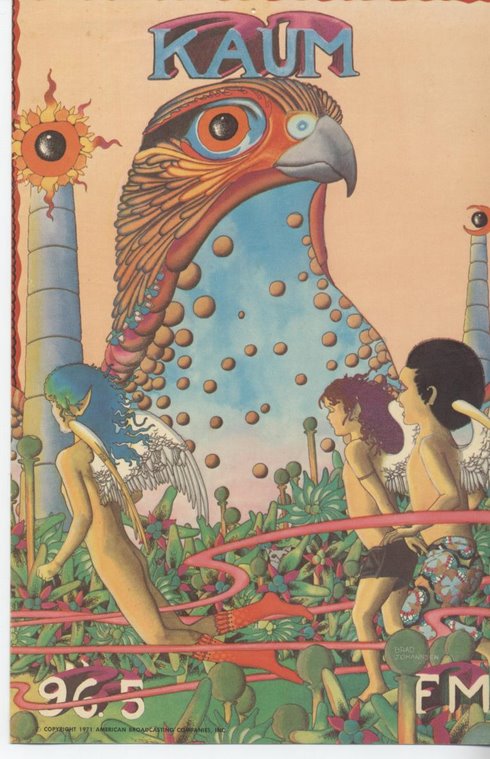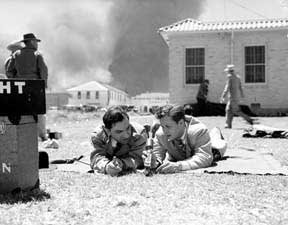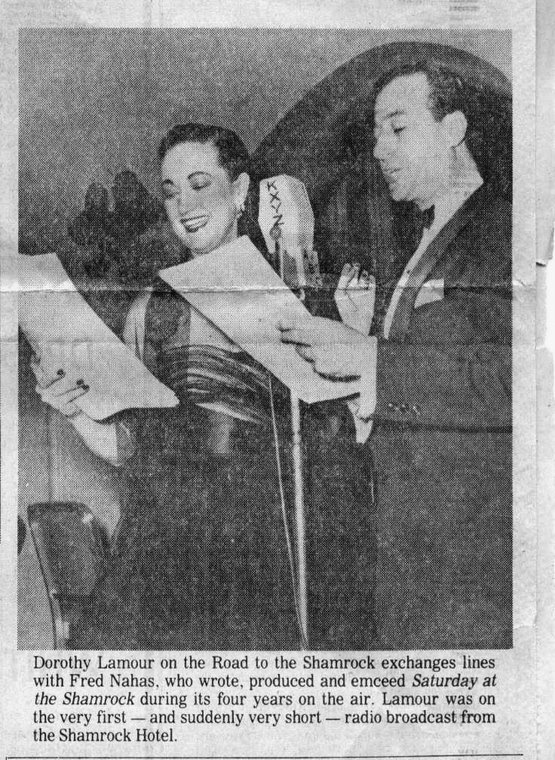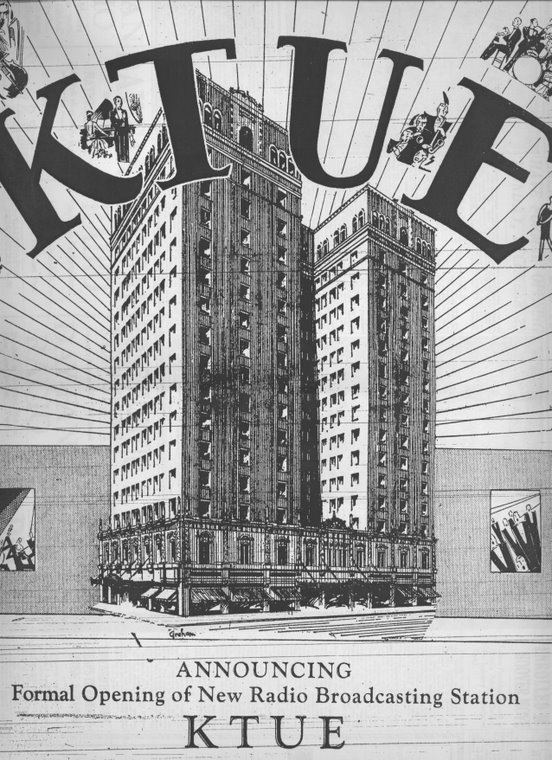Gallery II - WCAK and A.P. Daniel photos
Note: I have received some great informaton from Mike Schultz of Reverse Time Page identifying the equipment in these photographs and putting them in historical order. Mike's comments have been added below in italics. Check out Mike's site and enjoy! Bruce, 6/27/07
Note # 2: A second image of Daniel's house has been added with the tree leafed out; this picture is considerably darker but may allow a better view of the antenna. Bruce, 7/2/07.
I've had the pleasure of meeting Chris Varela, a Houston native who is on the Harris County Historical Commission and is very knowledgeable and passionate about Houston history in general and the history of Houston radio in particular. Early in his research, more than 10 years ago, Chris started trying to locate descendants or relatives of Houston radio pioneers and over the years this had led to some spectacular finds. A niece of Alfred P. Daniel, Mrs. Jerry T. Millar, gave Chris an old family album full of pictures of Daniel, his various installations, and other members of the Houston Radio Club. When we met, I took a few snapshots of some of the photos to post here. We are planning on having them scanned so this will be just a temporary gallery but I just couldn't wait to share these photos. I didn't realize until I had gotten home that inadvertently I had selected photos that had all appeared in the book so these will be familiar to some of you. The placard on the wall identifies this as the set up for Daniel's Special Amateur station, 5ZX; note the row of batteries along the baseboard, and what do you think of the window coverings? Daniel gave up a promising career as a window decorator to get into broadcasting!
The placard on the wall identifies this as the set up for Daniel's Special Amateur station, 5ZX; note the row of batteries along the baseboard, and what do you think of the window coverings? Daniel gave up a promising career as a window decorator to get into broadcasting!
Mike: Phonograph-that's a Cheney, but don't know the model. A tube transmitter is to the right of the phonograph. It looks commercially made, but I can't identify it. Under the desk is a motor-generator unit used to provide power for the transmitter, and a bunch of wet cell batteries. I can't identify the horn speaker either. It almost looks like it was a converted phonograph horn, rather than one that was made to be a radio speaker from the start. On the wall are framed licence certificates and the small cards are ham QSL cards.  Despite the card for 5AO visible to the right of the typewriter, this is presumed to be Daniel's set up for WCAK. If any readers of this blog can help in identifying any of the equipment in this photo or any of the others, please use the comments option below or email me (on the profile page on the right sidebar). NOTE: WE WERE WRONG ABOUT THIS BEING WCAK -- SEE MIKE'S COMMENTS AT THE BOTTOM -- THIS IS THE EARLIEST PICTURE.
Despite the card for 5AO visible to the right of the typewriter, this is presumed to be Daniel's set up for WCAK. If any readers of this blog can help in identifying any of the equipment in this photo or any of the others, please use the comments option below or email me (on the profile page on the right sidebar). NOTE: WE WERE WRONG ABOUT THIS BEING WCAK -- SEE MIKE'S COMMENTS AT THE BOTTOM -- THIS IS THE EARLIEST PICTURE.
Mike: To the left of the typewriter, at the bottom, is a Grebe CR-2 receiver. I can't identify the unit above it, but it appears to be an audio amplifier. Directly to the left is a DeForest receiving tuner consisting of three subsections (top and bottom are variable condensers and center is a coil mount). To the left of the big knife switch is a stack of coils that went with the DeForest unit. DeForest made what they called "Interpanel" radios, which were like radio Erector Sets. They could have as many as maybe 15 of these small panels. The headphones are by Baldwin. The wall phone was old when the picture was taken, and is circa 1905. I think that light bulb shaped thing on the wall is a thermometer. Pretty neat item. There's some really rare and valuable stuff in these pictures.  Readers who have been following this blog will recognize this photo - it was part of the illustration accompanying an article on the Houston Radio Club's exhibit at the Houston Fair and Exposition in 1921 mentioned in the post about the Pre-broadcast era - and is supposed to be Alfred Daniel's first microphone, made using a candlestick telephone. Daniel had loaned the picture to the paper for the article.
Readers who have been following this blog will recognize this photo - it was part of the illustration accompanying an article on the Houston Radio Club's exhibit at the Houston Fair and Exposition in 1921 mentioned in the post about the Pre-broadcast era - and is supposed to be Alfred Daniel's first microphone, made using a candlestick telephone. Daniel had loaned the picture to the paper for the article.
Mike: The tube is almost certainly a Western Electric Signal Corps VT-2, which was sold into the civilian market in large numbers after WW-I. The phone would appear to be one that was made for use in an intercom system (notice the pushbutton on the base). Can't identify the make, but it looks pretty early.  The Alfred P. Daniel home at 2504 Bagby, long since demolished. Daniel operated 5AO, 5ZX, and WCAK from the parlor of this house.
The Alfred P. Daniel home at 2504 Bagby, long since demolished. Daniel operated 5AO, 5ZX, and WCAK from the parlor of this house.
 This is presumably the upstairs room at the Daniel house used as a studio; note the 2 microphones.
This is presumably the upstairs room at the Daniel house used as a studio; note the 2 microphones.
Mike: Based on the appearance of the mikes, this picture is later, maybe late 20's. The picture isn't clear enough to identify the mikes. It may be a different phonograph than in the other views.  A couple of promotional cards printed by Alfred P. Daniel. The designation 263 meters indicates this card was printed after Daniel was allowed to move off the crowded 360 meters. Chris Varela says the slogan "Where 18 Railroads Meet the Sea" was created by a preacher; it was widely used, appearing often in special sections of the Chronicle boasting about Houston's commerce and industry.
A couple of promotional cards printed by Alfred P. Daniel. The designation 263 meters indicates this card was printed after Daniel was allowed to move off the crowded 360 meters. Chris Varela says the slogan "Where 18 Railroads Meet the Sea" was created by a preacher; it was widely used, appearing often in special sections of the Chronicle boasting about Houston's commerce and industry.
Mike: The "rack" on the wall is a transmitting inductance. It looks quite out of place being that it would be for a much higher powered transmitter than the one on the desk. The card says "four 5 watt tubes". That looks right for the transmitter on the desk. In this case, the tubes would be UV-202 types, or perhaps more VT-2's (they were cheaper). 
 Louis Peine who worked for Hurlburt-Still and WEV and later for General Electic. This is the photo on the cover of Chris's book and is unfortunately a little fuzzy in part because the photo was not flat.
Louis Peine who worked for Hurlburt-Still and WEV and later for General Electic. This is the photo on the cover of Chris's book and is unfortunately a little fuzzy in part because the photo was not flat.
Mike: There is an unidentified transmitter on the desk, and to it's right, a Kennedy type 110 receiver with a matching Kennedy audio amplifier. The horn speaker (looks like it's attached to the guy's head) is a King "Amplitone". You would clamp a pair of headphones to the two branches at the bottom, and it would work as a speaker.
The second picture is the earliest, and it shows the bottom of the transmitting inductance on the wall, and components to the left of what must be a high power spark transmitter, of a type that a ham would have used circa 1915-1920. This would not have been suitable for voice transmission. This would have been followed by the one on the WCAK card. The inductance is still there, but a tube transmitter (for voice) has replaced the rest of the spark transmitter. The first picture is a bit later, and the inductance is gone, and curtains have appeared.  Unfortunately the fuzziest of them all, my fault for moving when I snapped the picture and not having enough space on the picture card to take a second shot. Center front, sitting on the floor, is Alfred P. Daniel; just to the right Eleanor Regan. On the right end of the first row is Louis Peine. Next to Eleanor Regan, just above Daniel, possibly kneeling, is Hallet Worthington. Second from the left, front row, Alfred Neal Dargan. I didn't discuss this with Chris but looking at the photo later, I came to the conclusion that second from the right in the second row may be Ingraham S. Roberts III; looks like someone Chris pointed out to me in other pictures. I'll let him correct me on that.
Unfortunately the fuzziest of them all, my fault for moving when I snapped the picture and not having enough space on the picture card to take a second shot. Center front, sitting on the floor, is Alfred P. Daniel; just to the right Eleanor Regan. On the right end of the first row is Louis Peine. Next to Eleanor Regan, just above Daniel, possibly kneeling, is Hallet Worthington. Second from the left, front row, Alfred Neal Dargan. I didn't discuss this with Chris but looking at the photo later, I came to the conclusion that second from the right in the second row may be Ingraham S. Roberts III; looks like someone Chris pointed out to me in other pictures. I'll let him correct me on that.
We looked to see if Howard Huges was present but couldn't identify him.










4 comments:
In your Houston Radio Club photo, the guy wearing glasses and sitting between Mrs. Eleanor Regan and Louis Peine is Frank Austin.
Can you post short biographies of these people you name in the photo and why they were significant in Houston broadcasting?
Great job, Bruce. You have really put a lot of hard work into the research for your blog. It is very enjoyable and a great radio history lesson, which I appreciate. Thank you and continued success.
Thanks very much anonymous. Do you know any more about Austin? I know he was involved with WEAY, Will Horwitz' station off and on, but not much more. Hallett Worthington was, I think, a student at Rice. Ingraham S. Roberts was descended from a well-to-do family that had a big mansion on lower Main, in the 400 block, which is where the wealthiest families in town lived at one time. In fact it seems clear that many of those in the Houston Radio Club were from well-to-do families and lived in the Montrose area and what is now known as Mid-Town but then I think was South End. Alfred P. Daniel seems to have been more working class, though living in that part of town. Chris Varela has determined that Ben Still resided in Brookline, a community on the southeast side, basically just north of present day Gulfgate Mall. His earliest wireless activity took place from his home there. There will eventually be a 'People' section on the blog; I'll be posting a bio of Will Horwitz and running down some early KPRC performers soon. There will also eventually be a 'Who Was First' discussion.
As I pointed out in the Statement of Purpose, this is a work in progress and I have a lot of gaps. I eventually hope to know much more about lots of these people but I don't have the patience to wait several years before beginning to share what I've found.
Thanks very much Chuck. And congratulations on your position. They shoulda made you PD, of course.
Post a Comment